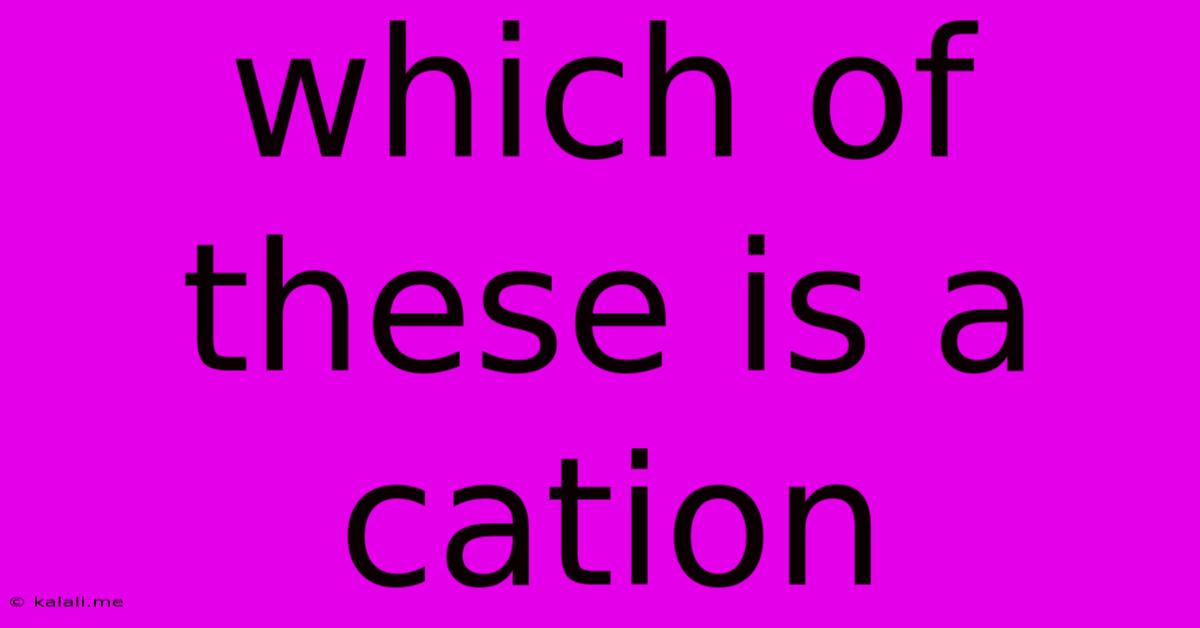Which Of These Is A Cation
Kalali
Jun 15, 2025 · 3 min read

Table of Contents
Which of These is a Cation? Understanding Ions and Their Charges
This article will explore the concept of cations, explaining what they are, how they're formed, and how to identify them amongst other ions. Understanding cations is crucial for grasping fundamental chemistry concepts. We'll delve into examples and provide a clear explanation to help you confidently determine which ion is a cation.
A cation is a positively charged ion. This means it has more protons than electrons. This positive charge arises from the loss of one or more electrons, typically from the outermost electron shell (valence shell). This process is called ionization. The opposite of a cation is an anion, which is a negatively charged ion.
How Cations are Formed
Cations usually form when a metal atom loses electrons. Metals have low electronegativity, meaning they are less likely to attract electrons. They readily lose electrons to achieve a more stable electron configuration, often resembling the nearest noble gas in the periodic table. This stable configuration is driven by the octet rule, which states that atoms tend to gain, lose, or share electrons to have eight electrons in their outermost shell.
For example, a sodium atom (Na) has one electron in its outermost shell. It readily loses this electron to form a sodium cation (Na⁺), achieving a stable electron configuration similar to neon.
Identifying Cations
To identify a cation, look for the following characteristics:
- Positive Charge: The most obvious indicator is the presence of a "+" sign in its chemical formula. The number indicates the magnitude of the charge (e.g., Na⁺ has a +1 charge, Mg²⁺ has a +2 charge).
- Metallic Element: Cations are typically formed from metal atoms. While some nonmetals can form cations (e.g., ammonium ion, NH₄⁺), they are less common.
- Lower Number of Electrons: Compared to the neutral atom, a cation has fewer electrons.
Examples of Cations
Here are some common examples of cations:
- Sodium ion (Na⁺): Formed when a sodium atom loses one electron.
- Calcium ion (Ca²⁺): Formed when a calcium atom loses two electrons.
- Iron(II) ion (Fe²⁺): Formed when an iron atom loses two electrons.
- Iron(III) ion (Fe³⁺): Formed when an iron atom loses three electrons.
- Aluminum ion (Al³⁺): Formed when an aluminum atom loses three electrons.
- Ammonium ion (NH₄⁺): A polyatomic cation formed from one nitrogen atom and four hydrogen atoms. Note that this is a notable exception as it involves a nonmetal.
Distinguishing Cations from Anions
Remember, the key difference lies in the charge:
- Cations: Positively charged (+)
- Anions: Negatively charged (-)
Anions are often formed when nonmetal atoms gain electrons to achieve a stable electron configuration. Examples include chloride ion (Cl⁻), oxide ion (O²⁻), and sulfide ion (S²⁻).
Understanding the difference between cations and anions is fundamental to comprehending chemical bonding, ionic compounds, and various chemical reactions. By learning to identify cations based on their positive charge and their origin from metal atoms (with the exception of polyatomic ions like ammonium), you will significantly improve your understanding of chemistry.
Latest Posts
Latest Posts
-
The Female External Genitalia Are Collectively Referred To As The
Jun 15, 2025
-
In Which Hemisphere India Is Located
Jun 15, 2025
-
Which Of The Following Statements About Medieval Towns Is False
Jun 15, 2025
-
Which Of The Following Is Not A Barrier To Communication
Jun 15, 2025
-
How Many Significant Figures Does 500 Have
Jun 15, 2025
Related Post
Thank you for visiting our website which covers about Which Of These Is A Cation . We hope the information provided has been useful to you. Feel free to contact us if you have any questions or need further assistance. See you next time and don't miss to bookmark.